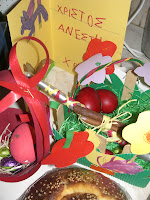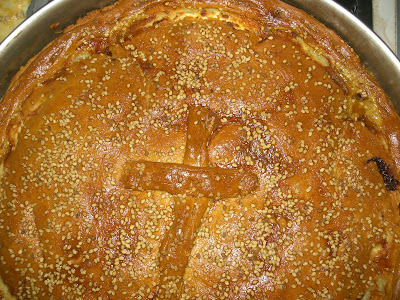
Celebrating Greek Easter in New Zealand wasn't easy; we had to celebrate Easter in two Easter instalments. First, we'd have the calendar holiday in March or April, when school would close early on Thursday and wouldn't open again until Wednesday. This was purely a mini-break for us; we were still in the middle of our fasting period, the Great Lent. Calendar Easter meant nothing to us. We were not moved when we saw the Pope on television announcing to the world that Christ had risen. In fact, we thought he was lying. Then, sometime between mid-April and early May, we'd experience the re-enactment of the crucifixion and resurrection of Jesus Christ, as the Greek Orthodox calendar dictated.
Calendar Easter and Greek Easter concurred every now and then, but it wasn't always guaranteed. This was the best case scenario, when I felt like a 'normal' New Zealander, and I didn't have to explain to anyone why I was still fasting after 'Easter Sunday'. One year in particular, I remember that calendar Easter fell at the end of March, while Greek Easter was scheduled for early May. That was the worst case scenario; the Kiwis were celebrating Easter Monday while we were just starting on the Great Lent with
Clean Monday.
It had been instilled in us that we would not go to Paradise if we broke the fast, which we sometimes did, but only 'accidentally.' We never told our
mother; we were more afraid of her wrath rather than the wrath of God. Even though we fasted quite strictly in our house for the whole of the Holy Week before Easter Sunday, we never felt as though we were 'suffering' while we were fasting. I hadn't read the Bible at that point, in which it states that a person who is fasting should never let anyone know they are fasting, but to keep a happy face and be in high spirits. In any case, the Great Lent was a good excuse to eat New Zealand crayfish, scallops and oysters. The only suffering you had to endure was knowing when to stop eating seafood before you got stomach cramps.
We went to church every night during the Holy Week. After closing the shop at 7pm, we'd rush to get home, wash and change into acceptable church attire, so that we would at least manage to hear the last part of the daily vespers service. On Palm Sunday, we patiently waited to be blessed with holy water, while on Holy Monday and Holy Tuesday night, there were mainly scripture excerpts. Holy Wednesday must have been an important service, given the significance placed by the Greek Orthodox church on fasting on that day, but I could only remember something about a prostitute and a barren fig tree.
My favorite night was Holy Thursday. In the morning, my mother would
dye red eggs for Greek Easter, before going to the fish shop. In the evening, we'd attend the church service with the readings of the twelve Bible excerpts, a candle being lit after each reading was finished. I liked the mathematics of the show, the symmetry of the lit candles, the Cross being brought out in the middle of the readings, the reverent procession made by the congregation to kiss it. It was all part of the culture I had been brought up in, far removed from the culture I stepped into at the end of the service as I walked out the door of the church, across the road from Todd Motors, the KFC and the late evening pub revellers from the Cambridge Hotel, the patrons of which would always be intrigued by the procession of the Epitafio on Good Friday and the dark solemn faces that followed it holding plain yellow mourning candles, late in the evening in the cold wet drizzle of a New Zealand autumn. A happy face was a definite no-no on that evening; we were reprimanded for smiling.
On Good Friday, our uncle would go out to a friend's country house in Levin and pick a couple of sheep from his farm. The dirty business was done there, and he'd drive back to Wellington with the carcasses. The meat was shared out between our families, with all the sheep's innards going to our house. Since I was more willing to help with the preparation of the meat, it was my sister's duty to cart them over from his house (down the road from ours) in a bucket. They ponged; the smell of manure would follow her from our uncle's house to our own. It was a good thing Easter always fell in a cold season; no one was out on their porches or verandahs to see her doing this. Her greatest fear was to be seen by a neighbour (all middle-class Pakehas all living in renovated Victorian bungalows) carrying an animal's intestines in a bucket in the middle of an inner-city suburb, as if she had just been milking a cow and was returning home with dung for the garden. What would they be saying? "There go those Greek girls, smelling like dagos."
The sheep's guts were transformed into the most delectable sausage-like sweetbreads imaginable (called gardoumia: γαρδούμια): sheep's stomach (tripe) cut into strips, with a little stomach fat, tied together with the intestines of the lamb, which had to be thoroughly cleaned, inside and out. These were made into an
egg-and-lemon soup for the midnight feast after the church service on Holy Saturday - we broke the fast with this soup - while the next day, we ate them stewed with zucchini in a red sauce for Easter Sunday. And it is these tripe and gut 'sausages' in
egg-and-lemon soup that make a traditional Cretan Easter meal, not
mayeiritsa - that's a mainland dish. Ditto the
lamb on the spit - again a mainland tradition imported to Crete, probably around the time that Cretan soldiers were recruited to help fight in the Albanian war. When they returned to their hometown, they bought with them new forms of cuisine that they had been treated to from mainland Greece. They are all nice once-a-year traditions, nevertheless, and unify us in the same way that a traditional English roast with Yorkshire pudding unifies Britons.
Holy Saturday signalled the grand finale of the re-enactment. We were allowed to wear our new clothes for the season to the church service which started at 11pm. The grieving period over, we held white candles, and we could laugh and smile as much as we wanted, but only after midnight, when Christ was risen. "Christos Anesti!" shouts the priest. "Alithos Anesti!" the congregation answers back. After everyone had kissed and wished each other a happy Easter, we walked back home, being one of the few remaining families who actually still lived in the earliest Greek neighbourhood of Wellington City, while most Greeks had moved out to the suburbs with the large houses, huge gardens and double-garages. My parents had remained in Mt Victoria, in the same way that they would have remained in their respective villages, had they never left the island of their birth.
The Holy Week signified the climax of the preparations preceding Easter. We'd be working in the fish shop every day of the week, but the
kalitsounia, the
koulourakia, the Easter meat pie, the sheep's guts (gardoumia), the
red eggs, the
tea breads (tsoureki) and the
avgolemono stew would all be prepared, cooked and ready for the grand feast after the church service on Easter Saturday, which ended in the early hours of Sunday morning. We pigged out at the midnight feast, felt no stomach pains afterwards, and still managed to eat another round of all this on Sunday at lunch, with the addition of barbecued lamb chops.
They say that spring lamb on the spit is the traditional meat dish for Greek Easter, but just consider the size of a New Zealand lamb - you'd need to re-landscape an inner-city garden to fit it; either that, or take the spit to a park. And as for the weather, April in Wellington was guaranteed to be cold, wet and windy. Barbecued lamb chops suited us just fine. I did try eating the Easter lunch on the balcony once; first I watched all the paper towels flying from our house in Mt Victoria all the way to Newtown, then I watched all the neighbours watching me litter their gardens.
On Easter Sunday, our appetite was whetted by the sights and smells of our traditional Greek mother's Easter meal. Our table was probably more laden with delicacies than the average Greek table in my parents' village. We were living in the land of plenty, unlike the land they themselves had emigrated from. The star attraction of the Easter meal was the traditional Cretan meat pie, something that my mother's Cretan family never made in the mountain village where she was raised, but was a staple of the Easter menu in
my father's coastal village. My mother would make the pastry and
mizithra (the local variety of ricotta cheese) herself to create this dish - neither of these products were available in the right form in New Zealand at the time, in order to make this pie authentically.
Celebrating Easter in traditional style is not the same as cooking a Sunday lunch. It needs special ingredients, special cooking methods, special recipes. We've planned our meal for that day, so we can shop accordingly. In Greece, it's better to shop early for the ingredients you will need. If you leave the shopping till the last two days before Easter, you will find that the best quality ingredients will have taken flight.

To make a 36cm-diameter
Cretan meat pie for Easter,
you need:
pizza doughchunks of boiled spring lamb (about 1.5kg of cooked boned meat), with the bone taken out
500g
mizithra (the local variety of soft curd cheese, similar to ricotta; a mixture of the local mizithra, malaka and staka can be used, if you can find these products - and you'll have to be living in Crete to do that!)a sprig of fresh mint, finely chopped
a beaten egg yolk, for brushing the pastry
salt, pepper and oregano
sesame seeds
Pick the meatiest parts of the lamb to use in this pie. If you use only the meat, then you're making a kreatopita - κρεατόπιτα (meat pie); if you leave the meat on the bone (as we used to do in New Zealand), then you're making a kreatotourta - κρεατότουρτα (meat torte). I prefer the kreatopita because it serves (and freezes) more easily. Kreatotourta is classically made in a round pie tray.
Make the dough as instructed in the recipe for
ladenia. Roll out a piece to line a 36cm tin. Place it on the greased tapsi - ταψί (what the Greeks call a baking tray). Season it with salt, pepper and oregano, according to taste. Place the meat chunks on it evenly. Sprinkle the mizithra over the meat, so that it spreads evenly over the pie. Sprinkle the mint over the cheese. Roll out another piece of pastry, leaving a small ball of pastry aside (the size of a golf ball). Cover the pie with the dough and seal it around the edges. Make an small opening at the top and bottom of the top pastry sheet (to let out trapped air in the pie while cooking). Cut the remaining dough into two pieces. Roll them out in a long thin shape, and place them in the centre of the pie to make the sign of the cross. Brush the pie with the beaten egg and sprinkle sesame seed all over it. Cook the pie in a moderate oven for approximately 45 minutes - only the pastry needs to be cooked, while the meat and mizithra cheese will amalgamate inside the pie with the heat.
And if you can't eat everything in one day, this pie freezes well, both cooked, uncooked and in servings. In my opinion, the best time to make this pie is
AFTER Easter, when there'll be plenty of leftover lamb from the spit, so you won't have to boil it, either.
©All Rights Reserved/Organically cooked. No part of this blog may be reproduced and/or copied by any means without prior consent from Maria Verivaki.
MORE EASTER TRADITIONS:
Tsoureki
Koulourakia
Red eggs
Seafood
Lent pies
Bakaliaros for Palm Sunday
Clean Monday
Fasting
Cretan Easter meat pie


